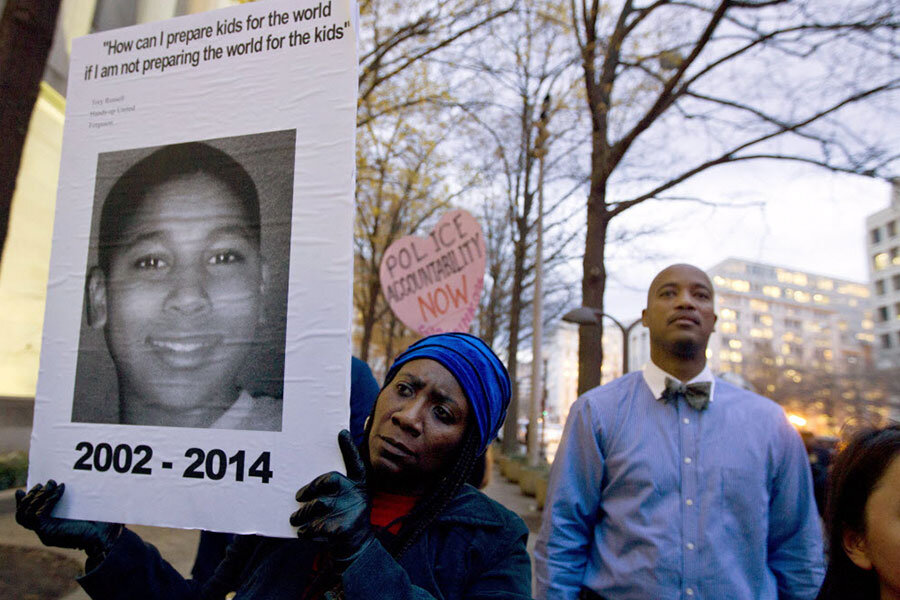Was fatal shooting of Tamir Rice justified? Expert reports say yes.
Loading...
| Columbus, Ohio
Prosecutors investigating the death of a 12-year-old black boy who was fatally shot by a white Cleveland police officer say they are just trying to be transparent in seeking and sharing outside reviews by experts in use of force. A lawyer for the boy's family, however, says the outside reports finding that the shooting was justified show that prosecutors are avoiding accountability.
The reports were released Saturday night by the Cuyahoga County Prosecutor's Office, which asked for the outside reviews as it presents evidence to a grand jury that will ultimately determine whether Timothy Loehmann will be charged in the November death of Tamir Rice, who was holding a pellet gun.
A retired FBI agent and a Denver prosecutor both found that the rookie patrolman who shot Tamir moments after pulling up beside him exercised a reasonable use of force because he had reason to perceive the boy – described in a 911 call as man waving and pointing a gun – as a serious threat.
"We are not reaching any conclusions from these reports," Prosecutor Timothy McGinty said in a statement. "The gathering of evidence continues, and the grand jury will evaluate it all."
He said the reports, which included a technical reconstruction by the Ohio State Highway Patrol, were released in the interest of being "as public and transparent as possible."
Subodh Chandra, a lawyer for the Rice family, said the release of the reports shows the prosecutor is avoiding accountability, which is what the family seeks.
"It is now obvious that the prosecutor's office has been on a 12-month quest to avoid providing that accountability," he said. He added that the prosecutor's office didn't provide his office or the Rice family with the details from the reports. He also questioned the timing of the release, at 8 p.m. Saturday on the Columbus Day holiday weekend.
"To get so-called experts to assist in the whitewash – when the world has the video of what happened – is all the more alarming," Mr. Chandra said. "Who will speak for Tamir before the grand jury? Not the prosecutor, apparently."
The killing of Tamir has become part of a national outcry about minorities, especially black boys and men, dying during encounters with police.
Both experts were provided with surveillance video of the shooting that showed Officer Loehmann firing at Tamir within two seconds after the police cruiser driven by his partner pulled up next to the boy. Police say the officers were responding to a call about a man with a gun, but were not told the caller said the gun could be a fake and the man an adolescent.
The report prepared by retired FBI agent Kimberly Crawford concluded that Loehmann's use of force did not violate Tamir's constitutional rights, saying the only facts relevant to such a determination are those the patrolman had at the time he fired his weapon.
Loehmann, she wrote, "had no information to suggest the weapon was anything but a real handgun, and the speed with which the confrontation progressed would not give the officer time to focus on the weapon."
"It is my conclusion that Officer Loehmann's use of deadly force falls within the realm of reasonableness under the dictates of the Fourth Amendment," Ms. Crawford wrote, though she noted she was not issuing an opinion as to whether Loehmann violated Ohio law or department policy.
Lamar Sims, the chief deputy district attorney in Denver, also concluded that Loehmann's actions were reasonable based on statements from witnesses and the reconstruction.
Mr. Sims said the officers had no idea if the pellet gun was a real gun when they arrived, and that Loehmann was in a position of great peril because he was within feet of Tamir as the boy approached the cruiser and reached toward his waistband.
"The officers did not create the violent situation," Sims wrote. "They were responding to a situation fraught with the potential for violence to citizens."
Chandra, the Rice family lawyer, says the experts "dodge the simple fact that the officers rushed Tamir and shot him immediately without assessing the situation in the least. Reasonable jurors could find that conduct unreasonable. But they will never get the chance because the prosecutor is working diligently to ensure that there is no indictment and no accountability."
The pellet gun Tamir was holding shoots non-lethal plastic projectiles but its orange markings had been removed.





